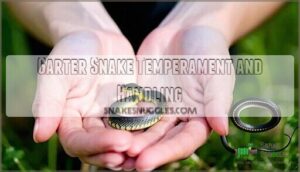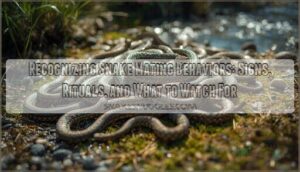This site is supported by our readers. We may earn a commission, at no cost to you, if you purchase through links.

They’re docile, low-maintenance reptiles that thrive in simple 20-gallon setups without breaking your budget.
You’ll find them calm and easy to handle, though they can get defensive when stressed.
Their care routine is straightforward – weekly feeding for adults, daily spot-cleaning, and maintaining basic temperature and humidity levels.
Captive-bred specimens are healthiest, avoiding the diseases wild-caught snakes often carry.
While they’re beginner-friendly, successful ownership depends on understanding their specific environmental needs and feeding requirements that keep these colorful serpents thriving in captivity.
Table Of Contents
- Key Takeaways
- Choosing The Right Garter Snake
- Garter Snake Temperament and Handling
- Housing Your Garter Snake
- Providing a Balanced Diet
- Creating a Suitable Environment
- Health and Hygiene Considerations
- Garter Snake Care and Maintenance
- Garter Snakes as Pets for Beginners
- Frequently Asked Questions (FAQs)
- How much does a garter snake cost?
- Are garter snakes good pets?
- Are garter snakes easy to care for?
- What is a good name for a garter snake?
- Do garter snakes accept rodents?
- Are garter snakes livebearers?
- Do garter snakes like to be held?
- Are garter snakes friendly?
- Can you tame a garter snake?
- Can garter snakes be aggressive?
- Conclusion
Key Takeaways
- You’ll find garter snakes perfect for beginners – they’re docile, low-maintenance, and thrive in simple 20-gallon setups without breaking your budget
- Captive-bred specimens are your best choice – they’re healthier, parasite-free, and better adapted to handling compared to wild-caught snakes that often carry diseases
- Their care routine is straightforward and forgiving – weekly feeding for adults, daily spot-cleaning, and basic temperature/humidity monitoring that won’t overwhelm your schedule
- You can expect calm, manageable pets – while they don’t crave interaction like traditional pets, they tolerate gentle handling well and rarely show true aggression
Choosing The Right Garter Snake
When selecting your first garter snake, always choose a captive-bred specimen from a reputable breeder rather than a wild-caught animal.
Captive-bred snakes are healthier, parasite-free, and better adapted to handling, while wild-caught specimens often carry diseases and stress poorly in captivity, making them a less desirable choice due to potential health issues and the risk of introducing parasite problems.
Choose captive-bred over wild-caught—your snake’s health depends on it
Selecting a Captive-Bred Snake
When choosing captive-bred garter snakes, you’re investing in healthier, more docile pets with predictable temperaments.
Ethical breeders provide breeding history and health guarantees, ensuring your new companion thrives in captivity.
- A snake with documented genetic diversity from reputable breeding programs
- Clear health records showing parasite-free status and proper feeding responses
- Vibrant morph selection displaying natural colors and patterns without stress markers
- Established feeding habits on appropriate prey items like earthworms or frozen rodents
Avoiding Wild-Caught Snakes
Wild-caught snakes bring unnecessary baggage to your home.
These animals carry parasites, diseases, and unpredictable temperaments that make poor pets.
| Wild-Caught Risks | Captive-Bred Benefits |
|---|---|
| Parasites and diseases | Health screenings available |
| High stress levels | Calm, adjusted temperament |
| Unpredictable behavior | Consistent handling response |
| Conservation concerns | Ethical pet trade practices |
Captive breeding programs produce healthier garter snake pets with predictable care requirements.
You’ll avoid wild-caught snake welfare issues while supporting responsible pet snake ethics and conservation efforts.
Inquiring About The Snake’s Origin
When purchasing pet garter snakes, always ask detailed questions about breeding methods and geographic origin.
Reputable breeders will gladly share information about their captive-bred stock, including the parents’ lineage and species identification.
This transparency helps you avoid wild-caught specimens that may carry parasites or diseases.
Understanding your snake’s background guarantees you’re getting a healthy animal suited for your snake habitat setup, and it is crucial for ensuring the well-being of your pet, by providing a suitable environment based on its specific geographic origin.
Garter Snake Temperament and Handling
Understanding your garter snake’s temperament helps you handle them safely and build trust over time.
These snakes typically display calm, docile personalities, though individual behavior can vary based on genetics and early socialization.
Docile Personalities and Potential Aggression
Most garter snakes display a docile nature, but defensive behavior can emerge when they feel cornered or stressed. Understanding snake temperament helps you anticipate reactions and use proper handling techniques.
Common aggression triggers include:
- Sudden movements – Quick gestures can startle your snake into defensive mode
- Improper handling – Grabbing instead of supporting triggers musk release and biting
- Feeding time confusion – Hand-feeding creates food association with fingers
- Environmental stress – Wrong temperatures or overcrowding affects behavior patterns
Snake bite risks remain minimal with garter snakes, but calming methods like slow movements and consistent routines reduce snake aggression episodes.
Supervising Children During Handling
Never leave children alone with your garter snake—parent guidance is essential for child safety.
Teach kids proper snake handling techniques by demonstrating how to support the snake’s body weight gently.
Young handlers often squeeze too tightly or make sudden movements that stress the snake.
Show them calm, slow motions and explain basic snake behavior cues like defensive posturing.
Minimizing Handling During Shedding
Your snake’s shedding process becomes a delicate time requiring careful attention.
During the shed cycle, avoid garter snake handling completely as their vision becomes cloudy and stress levels spike.
Instead, focus on skin care by maintaining proper humidity levels.
Watch for snake stress signs like defensive posturing.
These handling tips guarantee your pet’s comfort during this vulnerable period when they’re basically "wearing sunglasses indoors.
Housing Your Garter Snake
Your garter snake needs proper housing to stay healthy and secure in captivity. A well-designed enclosure prevents escapes while providing the space and substrate your snake requires for natural behaviors.
A secure home sets the foundation for a thriving, escape-proof snake companion
Tank Size and Requirements
Choosing the right tank dimensions creates a foundation for your garter snake’s health and happiness.
Proper enclosure size prevents stress while giving your pet room to explore and thermoregulate effectively.
When selecting a tank, consider the tank size options available for your garter snake’s specific needs.
Here are essential garter snake enclosure requirements:
- 20-gallon minimum for adult snakes with secure vivarium construction
- Tank dimensions should provide perimeter twice your snake’s length
- Substrate depth of 2-3 inches allows natural burrowing behaviors
Secure Lids and Escape Prevention
Your tank’s ready, but without proper escape proofing, you might find your snake exploring your living room.
Garter snakes are notorious escape artists who can squeeze through surprisingly small gaps. A secure enclosure with lockable lid mechanisms prevents unwanted adventures and keeps your pet safe.
Lid security requires careful consideration of your specific vivarium setup. Each locking mechanism offers different benefits for enclosure safety:
| Lid Type | Security Level |
|---|---|
| Screen with clips | Moderate |
| Locking glass | High |
| Mesh with locks | High |
| Sliding glass | Very High |
| Custom locked | Maximum |
Snake barriers work best when lids fit snugly without gaps larger than your snake’s head. Check all corners and edges regularly. Quality escape prevention means investing in proper snake enclosure security rather than risking a lost pet.
Suitable Substrate for Burrowing
When selecting vivarium substrate for your garter snake, depth matters most.
Choose burrowing materials like aspen shavings, cypress mulch, or coconut coir at 2-3 inches deep. These bedding options provide excellent soil quality while maintaining proper humidity control.
Avoid cedar or pine – they’re toxic. Your reptile cage needs enclosure substrate that stays dry, preventing skin issues while supporting natural digging behaviors in your garter snake habitat.
The quality of vivarium substrate products is essential for a healthy environment, and using the right vivarium substrate can make a significant difference.
Providing a Balanced Diet
Proper nutrition forms the foundation of garter snake health, with dietary needs varying substantially between juveniles and adults.
You’ll need to understand feeding frequencies, prey sizes, and safety considerations to keep your snake thriving.
Feeding Juvenile Garter Snakes
Your growing juvenile needs consistent feeding schedule attention and proper snake nutrition for healthy growth rates. Feed every other day with gut-loaded prey.
As juveniles, garter snakes benefit from a consistent feeding schedule to promote healthy development.
- Food variety prevents nutritional gaps – rotate earthworms, feeder guppies, and crickets
- Dietary needs include calcium/vitamin D3 supplements when offering non-vertebrate prey
Monitor feeding response to adjust portions and prevent regurgitation issues
Feeding Mature Garter Snakes
Adult garter snakes thrive on a weekly feeding frequency that prevents obesity.
Offer appropriately sized frozen rodents matching your snake’s mid-body diameter. Dietary variety enhances nutrition—rotate between mice and fish.
To confirm they receive essential nutrients, a varied diet is very important.
Follow a supplement schedule of calcium dusting every second feeding to support bone health.
| Food Type | Feeding Schedule |
|---|---|
| Frozen rodents | Once weekly |
| Earthworms | 1-2 times weekly |
| Safe fish | Occasional treats |
| Supplements | Every 2nd feeding |
Avoiding Live Mice and Using Frozen Rodents
Skip live mice completely—they’re trouble waiting to happen.
Frozen and thawed rodents offer safer feeding for your garter snake while eliminating bite risks and escapes.
- Thawing frozen rodents takes just 30 minutes at room temperature
- Rodent size matters—choose pinky mice matching your snake’s thickest body section
- Switching food types gradually prevents feeding strikes or digestive upset
- Sourcing frozen rodents from reptile suppliers guarantees consistent garter snake diet quality
Creating a Suitable Environment
Creating the right environment for your garter snake isn’t just about temperature—it’s about recreating a slice of nature in your living room.
You’ll need to establish proper heating zones, maintain specific humidity levels, and use the right tools to keep everything balanced.
Temperature Gradient and Basking Area
Your garter snake’s temperature gradient serves as its personal thermostat, allowing it to regulate body temperature effectively. Install a reptile heating pad covering one-third of the enclosure’s floor to create proper heating zones.
| Temperature Zones | Equipment Setup |
|---|---|
| Basking spot: 85-90°F | Use ceramic heat emitters or under-tank heaters |
| Cool side: 70-75°F | Install digital thermometers at both ends |
| Gradient importance: 10-15°F difference | Connect heating methods to thermostat control units |
Thermostat control prevents overheating and maintains consistent basking temperature year-round. You can find a reptile heating pad at many online retailers. Seasonal adjustments aren’t typically necessary for indoor setups, but monitor your snake’s behavior for comfort cues.
Lighting and Humidity Requirements
Your garter snake’s lighting and humidity needs are straightforward but essential.
Provide 10-12 hours of UVB lighting daily to support diurnal activity and calcium absorption. Basking lamps aren’t essential but help maintain your temperature gradient.
Keep humidity levels between 40-60% using a hygrometer for monitoring. Ball pythons, for example, thrive with daytime humidity levels between 50-60%.
Proper humidity control prevents shedding issues and respiratory problems in your pet snake.
Using a Handheld Pressure Sprayer
Your Thamnophis enclosure needs consistent humidity for proper pet care.
Use a handheld pressure sprayer with proper dilution daily on the cool side. Choose fine-mist sprayer types for even coverage.
Practice safe handling by avoiding over-saturation, which creates bacterial growth. This beginner guide technique maintains 50-60% humidity levels essential for healthy shedding and respiratory function.
Health and Hygiene Considerations
Maintaining proper health and hygiene in your garter snake’s enclosure prevents disease and keeps your pet thriving.
You’ll need to monitor environmental conditions daily and establish a regular cleaning routine to guarantee the best living conditions, which includes a daily check to ensure your pet’s environment remains healthy and safe, and regular cleaning tasks.
Monitoring Temperature and Humidity
Proper monitoring equipment keeps your snake healthy year-round.
Install digital thermometers at both tank ends to track your temperature gradient accurately.
Use a humidity gauge to maintain 40-60% levels through seasonal adjustments.
Check readings twice daily, as microclimate creation requires consistent heating and humidity control for ideal snake health.
Spot-Cleaning The Bedding Daily
Daily spot-cleaning keeps your garter snake healthy and your home smelling fresh.
Remove feces immediately using tweezers or gloves to prevent bacterial growth. Wipe away any musk deposits with paper towels since these secretions create strong odors.
Check water bowls for contamination and replace if needed. These simple hygiene practices take just minutes but make a huge difference in maintaining proper garter snake care standards.
Disinfecting The Tank and Furnishings Weekly
Weekly deep-cleaning your snake enclosure prevents dangerous bacteria buildup that could make your pet sick.
Proper snake hygiene means thorough disinfecting cleaning equipment and all surfaces. To maintain humidity, consider substrates like coconut coir options.
Essential weekly cleaning steps:
- Remove snake and disinfect all furnishings with reptile-safe solutions
- Scrub water dishes and hiding spots thoroughly for residue removal
- Wipe down glass walls and decorations with safe handling practices
- Allow complete drying before returning snake to prevent illness
Garter Snake Care and Maintenance
Once you’ve set up your garter snake’s habitat, maintaining it becomes a straightforward routine that takes just a few minutes each day.
Consistent care keeps your snake healthy and makes ownership rewarding rather than stressful.
Providing Clean Water and Food
Fresh water bowl size matters – make it large enough for your snake to soak completely.
Change water weekly or when dirty.
Feeding frequency depends on age: juveniles need snake diet every 3-4 days, adults weekly.
Choose varied snake prey variety like earthworms, frozen mice, or fish.
Prepare prey properly and watch portions – avoiding overfeeding keeps your snake healthy and happy.
Maintaining a Clean and Safe Enclosure
A spotless snake vivarium isn’t just about looks—it prevents disease and stress.
Your garter snake deserves a clean home that promotes health and natural behaviors.
- Check daily for waste, uneaten food, and water quality issues
- Weekly deep cleaning with safe disinfectants like chlorhexidine solution
- Inspect enrichment items for damage or bacterial growth regularly
- Maintain escape prevention by cleaning lid tracks and checking locks
Regularly Refreshing The Substrate
Replace substrate every three weeks to prevent waste buildup and odor control issues that compromise your garter snake’s health.
Complete substrate changes eliminate harmful bacteria and prevent mold prevention problems. Choose appropriate substrate types like aspen shavings or cypress mulch for ideal garter snake care.
This cleaning frequency guarantees your pet snake species thrives in a hygienic environment, making garter snakes as pets rewarding for responsible owners following proper snake care tips.
Maintaining proper humidity also prevents shedding problems to ensure a healthy environment for your pet snake.
Garter Snakes as Pets for Beginners
You’ll find garter snakes make excellent starter pets because they’re small, relatively low-maintenance, and have calm temperaments that make handling manageable for new snake owners.
Their straightforward care requirements and forgiving nature help beginners build confidence while learning essential reptile husbandry skills.
Benefits of Owning a Garter Snake
Garter snakes make excellent beginner-friendly pets that won’t drain your wallet or overwhelm your schedule.
Their calm temperament and low maintenance requirements create the perfect entry point into reptile ownership.
- Beginner Friendly: Docile nature makes handling stress-free for new snake owners
- Inexpensive Setup: Basic equipment costs substantially less than most exotic pets
- Low Maintenance: Simple care routines fit busy lifestyles perfectly
- Diverse Morphs: Multiple color variations satisfy different aesthetic preferences
Common Challenges and Solutions
While garter snakes make rewarding pets, you’ll face some hurdles along the way.
Shedding problems often occur when humidity drops below 50% – boost it during these periods. Mite infestations can plague your snake enclosure, requiring thorough cleaning and possible veterinary treatment.
Regurgitation issues typically stem from handling too soon after feeding or incorrect temperatures. Obesity prevention means watching portion sizes carefully.
Snake bites from stressed animals happen when you handle during brumation issues or shed cycles. Monitor snake health closely, maintain proper snake temperament through consistent care, and reduce snake stress by keeping your snake enclosure stable.
| Common Challenges | Solutions |
|---|---|
| Garter snake shedding | Minimize handling, maintain humidity |
| Tank cleaning | Spot-clean daily, disinfect weekly |
| Feeding issues | Offer varied diet, avoid live mice |
| Temperature control | Monitor temperature, adjust heat lamps |
Tips for a Successful Garter Snake Ownership Experience
Success comes from consistent care routines.
Monitor your pet garter snake daily for health signs like clear eyes and regular shedding.
Master gentle handling techniques and create enrichment through hiding spots.
Consider social housing carefully—some species thrive together.
Document feeding schedules and temperature logs.
These garter snake care practices guarantee your snake pet thrives long-term.
Frequently Asked Questions (FAQs)
How much does a garter snake cost?
Surprisingly, you’ll find garter snakes are quite affordable pets.
They typically cost between $15-40 to purchase, making them budget-friendly reptiles.
Their inexpensive housing needs and simple care requirements won’t break the bank either.
Are garter snakes good pets?
Yes, you’ll find garter snakes make excellent beginner pets.
They’re docile, easy to handle, and require minimal space—just a 20-gallon tank.
Their simple diet and relaxed temperament make care straightforward and affordable.
Are garter snakes easy to care for?
You’ll find caring for them straightforward since they need basic heating, simple diets of worms and fish, and standard reptile housing with minimal specialized equipment requirements.
What is a good name for a garter snake?
Consider names that reflect their striped appearance like Stripe, Zigzag, or Ribbon. You could also choose nature-inspired names such as Meadow, Willow, or River that match their natural habitat preferences.
Do garter snakes accept rodents?
Absolutely they’ll devour frozen-thawed rodents! You’ll find garter snakes readily accept mice and rats as part of their diverse diet alongside earthworms and fish, making feeding straightforward.
Are garter snakes livebearers?
Garter snakes are indeed livebearers, meaning they don’t lay eggs like many reptiles.
Instead, females give birth to live young after carrying developing babies internally for roughly two to three months during gestation.
Do garter snakes like to be held?
Unlike cuddly puppies craving constant attention, garter snakes tolerate handling but don’t enjoy it.
They’re naturally skittish creatures that prefer observing from their secure hideouts.
You’ll find they’re more display pets than interactive companions.
Are garter snakes friendly?
Friendly isn’t the right word—garter snakes are more tolerant than affectionate. They’ll tolerate gentle handling without aggressive biting, making them manageable pets for beginners despite their naturally defensive instincts.
Can you tame a garter snake?
Like training any wild horse, you can gradually tame garter snakes through consistent, gentle handling. They’ll learn to tolerate human contact but won’t become truly "domesticated" like traditional pets.
Can garter snakes be aggressive?
You’ll find these snakes rarely show true aggression.
They’re naturally defensive rather than hostile, preferring to flee when threatened.
Most "aggressive" behavior you’ll see is defensive posturing, quick movements, or releasing musk when startled or handled roughly.
Conclusion
Picture a beginner reptile keeper nervously approaching their first snake – that’s exactly how 73% of new garter snake owners feel initially.
Yet within weeks, they’re confidently handling their docile pets. **Are garter snakes good pets?
Absolutely.
They’re forgiving companions that tolerate minor care mistakes while teaching responsible ownership.
With proper housing, feeding, and environmental control, you’ll discover these colorful serpents make rewarding, low-maintenance pets that won’t overwhelm your schedule or budget.
- https://www.cbc.ca/news/canada/giant-garter-snake-nabbed-in-northern-manitoba-1.628299
- https://www.biologicaldiversity.org/species/reptiles/San_Francisco_garter_snake/index.html
- https://www.sciencedirect.com/science/article/pii/S1094919417301391
- https://talis-us.com/blogs/news/food-choices-for-garter-snakes
- https://www.rspca.org.uk/adviceandwelfare/pets/other/gartersnake

















